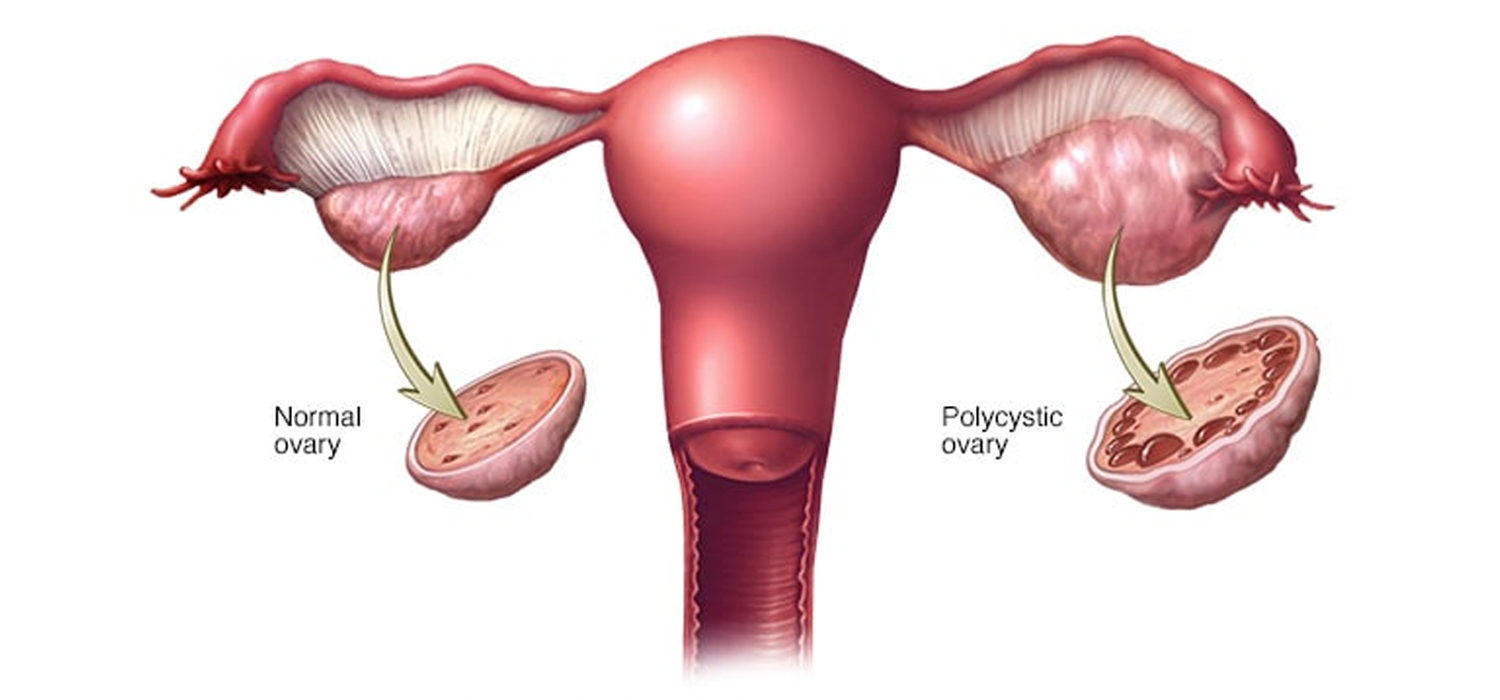PCOD
Overview
Polycystic ovary syndrome (PCOS) is a common hormonal condition that affects women of reproductive age. It usually starts during adolescence, but symptoms may fluctuate over time.
PCOS can cause hormonal imbalances, irregular periods, excess androgen levels and cysts in the ovaries. Irregular periods, usually with a lack of ovulation, can make it difficult to become pregnant. PCOS is a leading cause of infertility.
PCOS is a chronic condition and cannot be cured. However, some symptoms can be improved through lifestyle changes, medications and fertility treatments.
The cause of PCOS is unknown but women with a family history or type 2 diabetes are at higher risk.

Key facts
- Polycystic ovary syndrome (PCOS) affects an estimated 8–13% of reproductive-aged women.
- Up to 70% of affected women remain undiagnosed worldwide.
- PCOS is the commonest cause of anovulation and a leading cause of infertility.
- PCOS is associated with a variety of long-term health problems that affect physical and emotional wellbeing.
- PCOS runs in families, but there are ethnic variations in how PCOS manifests itself and how it affects people.
Cause of PCOS
PCOS a significant public health problem and is one of the commonest hormonal disturbances affecting women of reproductive age. The condition affects an estimated 8–13% of women of reproductive age, and up to 70% of cases are undiagnosed.
The prevalence of PCOS is higher among some ethnicities and these groups often experience more complications, in particular related to metabolic problems.
The biological and psychological effects of PCOS, particularly those related to obesity, body image and infertility, can lead to mental health challenges and social stigma.
Transmission of AIDS
HIV can be transmitted via the exchange of body fluids from people living with HIV, including blood, breast milk, semen, and vaginal secretions. HIV can also be transmitted to a child during pregnancy and delivery. People cannot become infected with HIV through ordinary day-to-day contact such as kissing, hugging, shaking hands, or sharing personal objects, food or water.
People living with HIV who are taking ART and have an undetectable viral load will not transmit HIV to their sexual partners. Early access to ART and support to remain on treatment is therefore critical not only to improve the health of people living with HIV but also to prevent HIV transmission.
Risk factors
Behaviours and conditions that put people at greater risk of contracting HIV include:
- having anal or vaginal sex without a condom;
- having another sexually transmitted infection (STI) such as syphilis, herpes, chlamydia, gonorrhoea and bacterial vaginosis;
- harmful use of alcohol or drugs in the context of sexual behaviour;
- sharing contaminated needles, syringes and other injecting equipment, or drug solutions when injecting drugs;
- receiving unsafe injections, blood transfusions, or tissue transplantation; and
- medical procedures that involve unsterile cutting or piercing; or accidental needle stick injuries, including among health workers.
Diagnosis of PCOS
Polycystic ovary syndrome is diagnosed by the presence of at least two out of the following:
- signs or symptoms of high androgens (unwanted facial or bodily hair, loss of hair from the head, acne or an elevated blood level of testosterone) – after other causes for this have been excluded;
- irregular or absent menstrual periods – after other causes for this have been excluded; and
- polycystic ovaries on an ultrasound scan.
Blood tests can be used to identify characteristic changes in hormone levels, although these changes are not universal. Women with polycystic ovary syndromemay have elevated levels of:
- testosterone (an ovarian androgen hormone that influences hair growth);
- oestrogen (an ovarian hormone that stimulates growth of the womb lining (endometrium);
- luteinising hormone (LH, a pituitary hormone which influences hormone production by the ovaries and is important for normal ovulation);
- insulin (a hormone that is principally involved in utilization of energy from food); and
- anti-müllerian hormone (which is measures the fertility level of the ovaries).
When making a diagnosis, doctors also take into account that irregular periods and ovulation can be a normal part of puberty or menopause, having polycystic ovaries may run in families, and women with a family history of PCOS or type 2 diabetes are at higher risk of PCOS. In addition, the ultrasound picture is not always clear and some women with PCOS may have an ultrasound scan that does not demonstrate polycystic ovaries.
Symptoms of PCOS
Symptoms of polycystic ovary syndrome can differ from person to person. Symptoms may change over time and often occur without a clear trigger.
Possible symptoms include:
- heavy, long, intermittent, unpredictable or absent periods
- infertility
- acne or oily skin
- excessive hair on the face or body
- male-pattern baldness or hair thinning
- weight gain, especially around the belly.
People with PCOS are more likely to have other health conditions including:
- type 2 diabetes
- hypertension (high blood pressure)
- high cholesterol
- heart disease
- endometrial cancer (cancer of the inner lining of the uterus).
PCOS can also cause anxiety, depression and a negative body image. Some symptoms such as infertility, obesity and unwanted hair growth can lead to social stigma. This can affect other life areas such as family, relationships, work and involvement in the community.
Treatment of PCOS
There is no cure for PCOS, but treatments can improve symptoms.
People who have irregular periods, trouble getting pregnant or excessive acne and hair growth should speak to a healthcare professional.
Some symptoms of PCOS can be reduced through lifestyle changes. Eating a healthy diet and getting enough exercise can help reduce weight and reduce the risk of type 2 diabetes.
Birth control medicines (contraceptive pill) can help regulate the menstrual cycle and reduce symptoms. Other medicines can reduce acne or unwanted hair growth caused by PCOS.
Treatments for infertility due to PCOS include lifestyle changes, medicines or surgery to stimulate regular ovulation. In-vitro fertilization (IVF) may be used but it has some risks
WHO’s Stance on PCOS
WHO works with Member States and partners to address PCOS as part of its efforts to improve women’s health and reproductive well-being globally. WHO works with governmental and non-governmental partners to enhance public awareness related to PCOS, and to generate guidance to healthcare providers on how it can be identified and treated. In addition, WHO promotes research related to the most effective ways of preventing, diagnosing and treating infertility due to PCOS, and identifies the most important unanswered questions related to it.
WHO supports the generation of statistics on how common infertility and its causes (such as PCOS) are. WHO helps member states to pay more attention to infertility and its causes within national health policies, services and financing to ensure that everyone who needs healthcare related to infertility is able to obtain it without financial hardship




